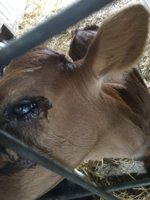Farmboss
Exploring the pasture
Hello everybody, I'm new to raising Calfs and need some help. I have a four week old Holstein and a five day old Jersey bull
And the Holstein has a knot on its jaw line the size of a big marble and it does move some , it's like a cyst .
And the jersey has the scours. But I just read somewhere that it should only get a quart of mr at a time because the don't drink as much as other breeds. So I may have overloaded him with mr and that could be why he has the scours. Any help and input is appreciated.
Farm on!
And the Holstein has a knot on its jaw line the size of a big marble and it does move some , it's like a cyst .
And the jersey has the scours. But I just read somewhere that it should only get a quart of mr at a time because the don't drink as much as other breeds. So I may have overloaded him with mr and that could be why he has the scours. Any help and input is appreciated.
Farm on!

